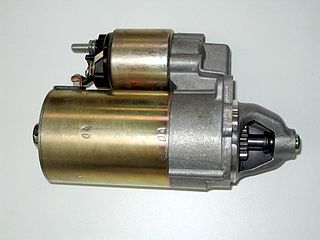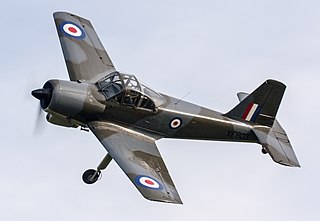
A starter is a device used to rotate (crank) an internal-combustion engine so as to initiate the engine's operation under its own power. Starters can be electric, pneumatic, or hydraulic. The starter can also be another internal-combustion engine in the case, for instance, of very large engines, or diesel engines in agricultural or excavation applications.

The Sopwith Pup is a British single-seater biplane fighter aircraft built by the Sopwith Aviation Company. It entered service with the Royal Naval Air Service and the Royal Flying Corps in the autumn of 1916. With pleasant flying characteristics and good manoeuvrability, the aircraft proved very successful. The Pup was eventually outclassed by newer German fighters, but it was not completely replaced on the Western Front until the end of 1917. The remaining Pups were relegated to Home Defence and training units. The Pup's docile flying characteristics also made it ideal for use in aircraft carrier deck landing and takeoff experiments and training.

The Fairey Battle is a British single-engine light bomber that was designed and manufactured by the Fairey Aviation Company. It was developed during the mid-1930s for the Royal Air Force (RAF) as a monoplane successor to the Hawker Hart and Hind biplanes. The Battle was powered by the same high-performance Rolls-Royce Merlin piston engine that powered various contemporary British fighters such as the Hawker Hurricane and Supermarine Spitfire. As the Battle, with its three-man crew and bomb load, was much heavier than the fighters, it was therefore much slower. Though a great improvement over the aircraft that preceded it, its relatively slow speed, limited range and inadequate defensive armament of only two .303 (7.7 mm) machine guns left it highly vulnerable to enemy fighters and anti-aircraft fire.

The Hawker Hind was a British light bomber of the inter-war years produced by Hawker Aircraft for the Royal Air Force. It was developed from the Hawker Hart day bomber introduced in 1931.

The Avro 504 was a First World War biplane aircraft made by the Avro aircraft company and under licence by others. Production during the war totalled 8,970 and continued for almost 20 years, making it the most-produced aircraft of any kind that served in any military capacity during the First World War. More than 10,000 were built from 1913 until production ended in 1932.

The Royal Aircraft Factory S.E.5 is a British biplane fighter aircraft of the First World War. It was developed at the Royal Aircraft Factory by a team consisting of Henry Folland, John Kenworthy and Major Frank Goodden. It was one of the fastest aircraft of the war, while being both stable and relatively manoeuvrable. According to aviation author Robert Jackson, the S.E.5 was: "the nimble fighter that has since been described as the 'Spitfire of World War One'".

The Hawker Nimrod is a British carrier-based single-engine, single-seat biplane fighter aircraft built in the early 1930s by Hawker Aircraft.
The Coffman engine starter was a starting system used on many piston engines in aircraft and armored vehicles of the 1930s and 1940s. It used a cordite cartridge to move a piston, which cranked the engine. The Coffman system was one of the most common brands; another was the Breeze cartridge system, which was produced under Coffman patents. Most American military aircraft and tanks which used radial engines were equipped with this system. Some versions of the Rolls-Royce Merlin engine used in the British Supermarine Spitfire used the Coffman system as a starter. The Hawker Typhoon and Hawker Tempest also used the Coffman system to start their Napier Sabre engines.

The Battle of Britain Memorial Flight (BBMF) is a Royal Air Force flight which provides an aerial display group usually comprising an Avro Lancaster, a Supermarine Spitfire and a Hawker Hurricane. The aircraft are regularly seen at events commemorating the Second World War and upon British State occasions, notably Trooping the Colour, celebrating Queen Elizabeth II's 80th birthday in 2006, as well as the wedding of Prince William and Catherine Middleton in 2011 and at air displays throughout the United Kingdom and Europe.

The Hawker Cygnet was a British ultralight sesquiplane aircraft of the 1920s.

The Hawker Tomtit is a British training biplane from the late 1920s.

The Shuttleworth Collection is a working aviation, automotive and agricultural collection located at the Old Warden Aerodrome, Old Warden in Bedfordshire, England.

The Hawker Hector was a British biplane army co-operation and liaison aircraft of the late 1930s; it served with the Royal Air Force and saw brief combat in the Battle of France in May 1940. Some Hectors were later sold to Ireland. It was named after the Trojan prince Hector.

The Avro Type 621 Tutor is a two-seat British radial-engined biplane from the interwar period. It was a simple but rugged basic trainer that was used by the Royal Air Force as well as many other air arms worldwide.

The Percival P.56 Provost is a basic trainer aircraft that was designed and manufactured by British aviation company Percival.

Hucknall Aerodrome was a former general aviation and RAF aerodrome located 5 nmi north north-west of Nottingham, Nottinghamshire, England, and west of Hucknall town. The aerodrome had been operated by the Merlin Flying Club since 1971 and then by Rolls-Royce Group plc. Before its closure, it was owned and operated by ITP Aero.

The Armstrong Whitworth Atlas was a British single-engine biplane designed and built by Armstrong Whitworth Aircraft. It served as an army co-operation aircraft for the Royal Air Force (RAF) in the 1920s and 1930s. It was the first purpose-designed aircraft of the army co-operation type to serve with the RAF.
Royal Air Force Bitteswell or more simply RAF Bitteswell is a former Royal Air Force satellite station located 2.0 miles (3.2 km) west of Lutterworth, Leicestershire and 6.1 miles (9.8 km) north of Rugby, Warwickshire, England.

Many variations of aircraft engine starting have been used since the Wright brothers made their first powered flight in 1903. The methods used have been designed for weight saving, simplicity of operation and reliability. Early piston engines were started by hand. Geared hand starting, electrical and cartridge-operated systems for larger engines were developed between the First and Second World Wars.



















